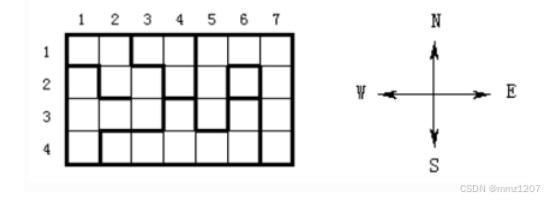Dungeon Master
题目描述
这题是一个三维的迷宫题目,其中用‘.’表示空地,‘#’表示障碍物,‘S’表示起点,‘E’表示终点,
求从起点到终点的最小移动次数,解法和二维的类似,只是在行动时除了东南西北移动外还多了上下。
可以上下左右前后移动,每次都只能移到相邻的空位,每次需要花费一分钟,求从起点到终点最少要多久。
输入格式
多组测试数据。
一组测试测试数据表示一个三维迷宫:
前三个数,分别表示层数、一个面的长和宽,后面是每层的平面图。前三个数据为三个零表示结束。
输出格式
最小移动次数。
样例
样例输入
3 4 5
S....
.###.
.##..
###.#
#####
#####
##.##
##...
#####
#####
#.###
####E
1 3 3
S##
#E#
###
0 0 0
样例输出
Escaped in 11 minute(s).
Trapped!
样例解释
对于题目给出数据的含义就是输入l,r,c,分别代表迷宫有l层,每层长宽分别是c,r。对于数据以可以这样移动:
(1,1,1)->(1,1,2)->(1,1,3)->(1,1,4)->(1,1,5)->(1,2,5)->
(1,3,5)->(1,3,4)->(1,4,4)->(2,4,4)->(2,4,5)->(3,4,,5)
共11步就可以到达终点 对于数据二明显不能到达,则输出Trapped!
这题用BFS解,每次去队首元素,如果是终点则输出结果移动的次数,否则,从该点开始分别向东南西北上下移动(如果可以走的话)并继续搜,如果到队列为空还没搜到解法,则说明无解。
#include <bits/stdc++.h>
using namespace std;
struct point
{
int x,y,z,v;
point(){};
point(int a,int b,int c,int d)
{
x = a;
y = b;
z = c;
v = d;
}
};
point que[1000010];
char a[110][110][110];
int b[110][110][110];
int head;
int tail;
int n,m,h;
int cnt;
int sx,sy,sz,ex,ey,ez;
int dx[] = {0,1,0,-1,0,0};
int dy[] = {1,0,-1,0,0,0};
int dz[] = {0,0,0,0,-1,1};
void print();
int main()
{
cin>>h>>n>>m;
while(h!=0||n!=0||m!=0)
{
cnt = 0;
head = 0;
tail = 0;
for(int i = 1;i<=h;i++)
{
for(int j = 1;j<=n;j++)
{
for(int k = 1;k<=m;k++)
{
cin>>a[i][j][k];
b[i][j][k] = 0;
b[i+1][j][k] = 0;
a[i+1][j][k] = '#';
if(i==1) a[i-1][j][k] = '#';
if(a[i][j][k]=='S') sx = j,sy=k,sz=i;
if(a[i][j][k]=='E') ex = j,ey=k,ez=i;
}
}
}
b[sz][sx][sy] = 1;
bool t = false;
que[++tail] = {sx,sy,sz,0};
while(head<tail)
{
head++;
for(int i = 0;i<6;i++)
{
int tx = que[head].x+dx[i];
int ty = que[head].y+dy[i];
int tz = que[head].z+dz[i];
if(tx>=1&&tx<=n&&ty>1&&ty<=m&&tz>=1&&tz<=h&&a[tz][tx][ty]!='#'&&b[tz][tx][ty]==0)
{
que[++tail] = {tx,ty,tz,que[head].v+1};
b[tz][tx][ty] = que[tail].v;
if(tz==ez&&tx==ex&&ty==ey)
{
t = true;
break;
}
}
}
if(t==true) break;
}
if(t==false) cout<<"Trapped!"<<endl;
else
{
cout<<"Escaped in "<<b[ez][ex][ey]<<" minute(s)."<<endl;
}
cin>>h>>n>>m;
}
return 0;
}
城堡The Castle
题目描述
一座城堡被分成m*n个方块(m<50,n<50),每个方块可有0~4堵墙(0表示无墙)。图中的加粗黑线代表墙。几个连通的方块组成房间,房间与房间之间一定是用黑线(墙)隔开的。现在要求你编一个程序,解决以下2个问题:1、该城堡中有多少个房间?2、最大的房间有多大?

输入格式
平面图用一个数字表示一个方块(第1个房间用二进制1011表示,0表示无东墙,用十进制11表示)。第一行一个整数m(m≤50),表示房子南北方向的长度。第二行一个整数n(n≤50),表示房子东西方向的长度。后面的m行,每行有n个整数,每个整数都表示平面图对应位置的方块的特征。每个方块中墙的特征由数字P来描述(0≤P≤15)。数字P是下面的可能取的数字之和:
1(西墙 west)
2(北墙 north)
4(东墙 east)
8(南墙 south)
室内的墙被定义两次:例如方块(1,1)中的南墙也被位于其南面的
方块(2,1)定义了一次。
建筑中至少有两个房间。
输出格式
第1行:1个整数表示房间总数:第2行:1个整数,表示最大房间的面积(方块数)、
样例
输入样例
4
7
11 6 11 6 3 10 6
7 9 6 13 5 15 5
1 10 12 7 13 7 5
13 11 10 8 10 12 13
输出样例
5
9
#include <bits/stdc++.h>
using namespace std;
struct node
{
int x,y,v;
node(){};
node(int a,int b,int c)
{
x = a;
y = b;
v = c;
}
};
node que[10010];
int a[60][60];
int b[60][60];
int cnt;
int cntt;
int ma;
int n,m;
int head,tail;
int dx[] = {0,1,0,-1};
int dy[] = {1,0,-1,0};
int main()
{
cin>>n>>m;
for(int i = 1;i<=n;i++)
{
for(int j = 1;j<=m;j++)
{
cin>>a[i][j];
}
}
cnt = 0;
ma = 0;
for(int i = 1;i<=n;i++)
{
for(int j = 1;j<=m;j++)
{
for(int k = 0;k<=tail;k++)
{
que[k] = {0,0,1};
}
if(b[i][j]==0)
{
cntt = 1;
head = 0;
tail = 0;
que[++tail] = {i,j,0};
cnt++;
b[i][j] = cnt;
while(head<tail)
{
head++;
for(int ii = 0;ii<4;ii++)
{
int tx = que[head].x+dx[ii];
int ty = que[head].y+dy[ii];
if(ii==0)
{
if((a[tx][ty]==2||a[tx][ty]==4||a[tx][ty]==8||a[tx][ty]==6||a[tx][ty]==12||a[tx][ty]==10||a[tx][ty]==14||a[tx][ty]==0)&&b[tx][ty]==0&&tx>=1&&tx<=n&&ty>=1&&ty<=m)
{
que[++tail] = {tx,ty,que[head].v+1};
b[tx][ty] = cnt;
cntt++;
}
}
else if(ii==1)
{
if((a[tx][ty]==1||a[tx][ty]==4||a[tx][ty]==8||a[tx][ty]==5||a[tx][ty]==12||a[tx][ty]==9||a[tx][ty]==13||a[tx][ty]==0)&&b[tx][ty]==0&&tx>=1&&tx<=n&&ty>=1&&ty<=m)
{
que[++tail] = {tx,ty,que[head].v+1};
b[tx][ty] = cnt;
cntt++;
}
}
else if(ii==2)
{
if((a[tx][ty]==2||a[tx][ty]==1||a[tx][ty]==8||a[tx][ty]==3||a[tx][ty]==11||a[tx][ty]==10||a[tx][ty]==9||a[tx][ty]==0)&&b[tx][ty]==0&&tx>=1&&tx<=n&&ty>=1&&ty<=m)
{
que[++tail] = {tx,ty,que[head].v+1};
b[tx][ty] = cnt;
cntt++;
}
}
else if(ii==3)
{
if((a[tx][ty]==2||a[tx][ty]==4||a[tx][ty]==1||a[tx][ty]==6||a[tx][ty]==3||a[tx][ty]==5||a[tx][ty]==7||a[tx][ty]==0)&&b[tx][ty]==0&&tx>=1&&tx<=n&&ty>=1&&ty<=m)
{
que[++tail] = {tx,ty,que[head].v+1};
b[tx][ty] = cnt;
cntt++;
}
}
}
}
ma = max(ma,cntt);
}
}
}
cout<<cnt<<endl<<ma;
return 0;
}




















 1820
1820

 被折叠的 条评论
为什么被折叠?
被折叠的 条评论
为什么被折叠?








